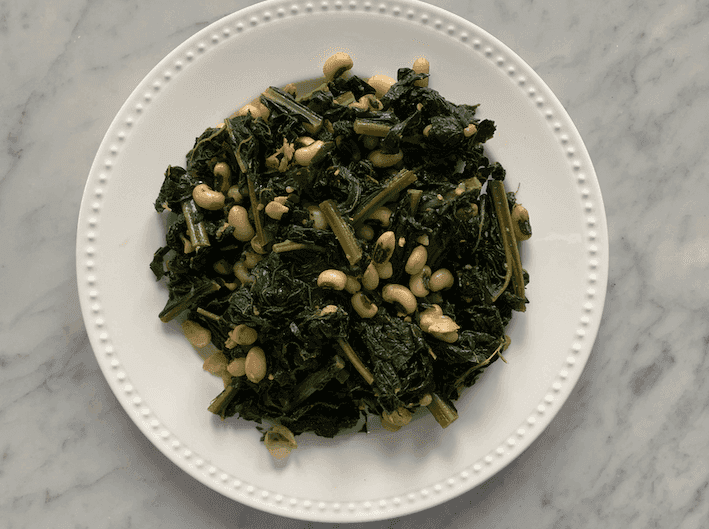Tamboura: Longevity Supermeal
by Amylee Amos PhD, RDN, IFMCPRecipes
Matcha, Goji berries, turmeric… you’re no stranger to hearing about the latest ‘superfood.’ While there’s no finite definition for superfoods, they’re normally especially nutrient dense plant foods. There’s no question that a diet rich in plant foods- any and all plant foods- best supports healthpsan and longevity. But some plants do pack a particularly potent nutritional punch, so including these foods in greater quantity makes a lot of sense. That’s why Tamboura should be on your weekly dinner menu. I call it a supermeal because it’s full of superfoods. This meal can do more for you than any drug or supplement on the market. Here’s why.
The star of the dish is kale. Kale has spent a lot of time in the limelight as a major superfood, and for good reason. Kale helps optimize cholesterol. It lowers the “bad” LDL cholesterol and increases the “good” HDL cholesterol (1). We’re quick to jump to pharmaceuticals when cholesterol levels are imbalanced, but perhaps in many cases, just increasing our kale intake could be a therapeutic intervention. Kale intake also raises antioxidant activity in the blood (1). This means that kale helps neutralize the oxidative stress that occurs in the body throughout the day. In this dish the kale is boiled, which makes it easier to chew and easier to digest. But won’t the boiling process destroy all of the compounds that impart those health benefits? Luckily, no. Boiling kale for up to 30 minutes not only doesn’t destroy many of kale’s beneficial compounds, but actually increases their potency (2).
Kale is also well studied for its anti-cancer benefits, along with its greater family of cruciferous vegetables. A study of the 34 most common vegetables looked into those with the greatest chemoprotective properties. The cruciferous vegetables like the different types of kale topped the charts, along with the allium family (3). Our second superfood in Tamboura is garlic. This allium vegetable has incredible anti-proliferative and antioxidant properties, making it a necessary part of a cancer and chronic disease fighting diet. In fact the researchers noted that intake of cruciferous and allium family vegetables is essential for cancer prevention.
The protein component of this meal comes from the black eyed peas. Though not as common as many other legumes, black eyed peas are available in canned or dried forms from most grocery stores. Beans are some of the most economical sources of healthy protein. In fact, research shows that legumes are the most important predictors of survival among older adults worldwide (4). All of the Blue Zones, the areas of the world with the densest populations of healthy centenarians, incorporate legumes in their diet. We have a lot to learn from them.
Beyond the kale, the garlic, and the black eyed peas, in Tamboura you’re also consuming phytonutrient rich sumac, cumin, and Aleppo pepper. The meal is nicely balanced in carbohydrate, protein, and fat with the extra virgin olive oil. All in all, this savory, flavorful dish is the perfect definition of a supermeal.
Like I said, if you want to boost your nutrition, start eating Tamboura. It has everything you need to power up your nutrition game and is a good way to introduce superfoods that you’re hopefully already eating. After all, with such remarkable nutritional power, you’d think we would be eating kale by the bushel, and we should! But the average American consumes 0.05 pounds of kale per year. That equates to about 1.5 cups of kale per person per decade (5). Pretty pitiful. And many of my clients have never tried black eyed peas, or even heard of sumac! Now is your chance to branch out and reap the benefits of these nutritional powerhouses!
Ingredients:
- 3 bunches of dinosaur kale
- ¼ cup EVOO
- 6 large garlic cloves, minced
- 1 can black eyed peas
- 1 tablespoon Aleppo pepper
- 1 tablespoon cumin
- 1 teaspoon salt
- 1 ½ tablespoon sumac
- ½ lemon
Directions:
- Wash and chop the kale and immerse it in a large pot of water.
- Bring to a boil and drain immediately.
- Place cooked kale into a large saute pan with EVOO and garlic. Saute over low heat.
- Rinse and drain the black eyed peas and add them to the kale. Stir well.
- Add Aleppo pepper, cumin, salt, and sumac and squeeze in the juice of the lemon. Mix well.
- Serve warm (optional: serve on a bed of cauliflower rice).
References:
1. Kim, S.Y. et al (2008). Kale juice improves coronary artery disease risk factors in hypercholesterolemia in men. Biomed Environ Sci, 21(2): 91-7.
2. Nishi, K. et al (2011). Immunostimulatory in vitro and in vivo effects of a water-soluble extract from kale. Biosci Biotechnol Biochem, 75(1): 40-6.
3. Boivin, D. et al (2009). Antiproliferative and antioxidative activities of common vegetables: a comparative study. Food Chem, 112: 374-80.
4. Darmadi-Blackberry, I. et al (2004). Legumes: the most important dietary predictor of survival in older adult people of different ethnicities. Asia Pac J Clin Nutr, 13(2): 217-20.
5. USDA Food Availability (per capita) Data System: Fresh Kale: per capita availability adjusted for loss.